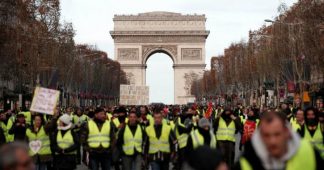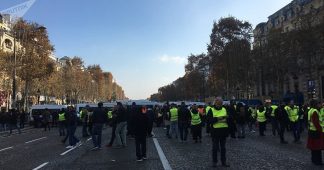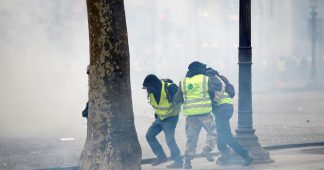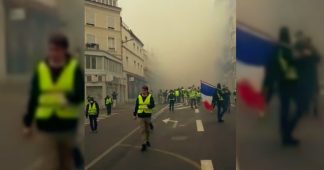by Bruno Drweski
After almost one year of mass mobilization, the yellow vest movement is still taking the streets but its activity is less impressive than at the beginning. People are often tired or fear different kinds of repression. Most of them need some break …Among policemen and other State administration employees on the other side the situation is quite similar. In the same time, we can observe that demonstrations organized by different trade union organizations, firefighters, public health employees, teachers, railway workers, etc. are multiply all over the country alongside with yellow vests and environmentalist demonstrations. Dissatisfaction is spreading also in almost all trade union organizations. But, most of the time, different forms of protests remain dispersed.
The movement of yellow vests keeps its anchor points on roundabouts, in local initiatives or assemblies, it therefore continues on the ground, but the method of organizing demonstrations every Saturday may have reached a degree of exhaustion, partly because the government is ignoring demonstrators and partly because there is no visible political outlet for this type of actions.
We are witnessing a situation where the fire continues to smoulder under the ashes in a France where more than two third of the society has understood that the existing system is basically wrong, inefficient for its interests and condemned by 60%-75% of the people. Only a core of 20%-25% supports it.
But, during demonstrations, we have gone quite spontaneously from mass demonstrations to “guerilla warfare” tactics used by the most conscious and experienced demonstrators. They gather here and there and move all the time from one place to another. That makes the situation more difficult for the repressive forces which cannot know who will arrive for example on the Champs-Elysées and from which street at the moment. This tactic has worked quite well on the Champs-Elysées in September and we suppose that this is the main reason mainstream medias preferred to ignore those demonstrations in the centre of the « rich districts » of Paris and prefer to show more « traditional » mass demonstrations in other parts of the French capital.
More generally, we believe France has entered a period of the rise of something like a “guerilla culture” of scattered groups aware that things will not change right away but that we must maintain a constant pressure with different forms of mobilizations so the government will not be able to know what will happen, where, when and by which …different yellow vests groups, or grassroots trade unions organizations, or horizontal grassroots union initiatives. For example we experienced this week a spontaneous mass railway strike that happened in almost half of the French territory after one accident that has shown how public services are suffering from lack of public investments. The attack by the State security police (CRS), a couple of days earlier, against firefighters taking the street peacefully for the same reason – lack of public investments – created strong dissatisfactions among very different social layers since firefighters are almost unanimously respected all over the country.
The issue now is to know what organizational from all these expressions of dissatisfaction will take at the very end and how things will resume to force the government and, behind it, the EU leadership, to retreat. …People expect something like a vanguard (avantguarde) organization while refusing in the same time to advocate any organization as all of them are considered as potential traitors of their social base, trying to make some deal with leading classes and institutions. This is the current state of mind of the majority of the French opinion not ready then to show any unconditional faith towards any « holy leader » or any « holy Church » or Party and Trade union as such. But on the same time, the government and mainstream media are showing they know they do not control the situation and the society. This is why they are reviving the « eternal French issue » of the Islamic headscarf, which has always been since the 2000s the indicator of a situation when power does not know any more what to invent to divide the people, preventing their unity. State power and mainstream media use this tactic when they feel obliged to seek the only tool they have to divide the people against a potential unitary mobilization because their system cannot imagine any new and real perspective of social progress for the masses. Especially when we can observe a similar situation almost all over the capitalist world, Lebanon, Iraq, Ecuador, Chile, Spain, Algeria, Haiti, etc.











